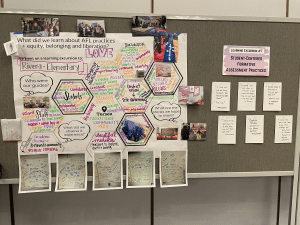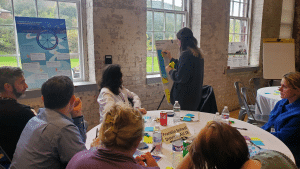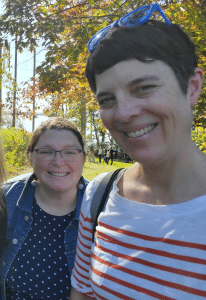School Site Visits: A Powerful Lever in School Transformation
CompetencyWorks Blog

How do we help communities who are looking to improve their local schools see the possibilities? How do we help them imagine new ways to do school? What’s a relatively easy way to see a change idea in progress before committing resources, time, and energy? School Site Visits!
Whether done as an informal, localized event or part of a larger conference or hosted visit, site visits promise unique insights, tangible examples to adopt or adapt, and professional growth. As part of our work with individual schools and larger networks focused on school transformation, both of us – sometimes together – have had the opportunity to do different types of site visits with various groups. We thought it would be good to share our observations of some of the benefits this type of learning holds.
Different Approaches to Site Visits
Site visits, in whatever form, are a tool that can be used throughout the phases of a change process. In the planning stages of transformation and change, teams often organize visits to places further along in their implementation journey to inform their own vision. This can happen at different levels – as when Utah included visits in its planning year or when a Red Bank Elementary team from South Carolina visited Lindsay, CA.
Community-of-practice networks plan site visits to learn from each other as network members implement new practices. Such learning visits can be embedded into longer-term collaboration, where educators collaborate before and after visits to give feedback on plans and also on what they see in practice as those plans get implemented. Boston’s Barr Foundation regularly supports this type of site visit as part of its “Doing High School Differently” work in New England.

Conferences sometimes include opportunities for site visits, whether as a pre-conference option or as part of the programming. For example, at the Assessment for Learning convening in Tucson in February 2023, the conference schedule integrated site visits to Tucson Unified School District and Sunnyside Unified School District as part of the programming for all participants. As part of a mini-grant from Assessment for Learning, the Alternative Choices in Education (ACE) team, we planned a local site visit with six visitors from five schools and organizations. Other districts who have had many visitors over the years offer their own site visit events, such as in Lindsay Unified School District.
And, site visits can be pretty simple. We volunteered to assess Senior Projects at Francis W. Parker Charter School and took a couple of teachers from Franklin High School with us. They were able to experience life in a different school for a couple of hours, which provided them an opportunity to reflect on their own practice and experience. Aside from getting a couple of substitutes and a few emails with the Parker School folks, it was a pretty easy visit, with a big impact for two teachers who have only had experience in one or two schools.
Five Benefits to Site Visits
1. Gain Understanding of Transformative Practices
Experiential learning about new practices and models helps people to comprehend more deeply and accurately. Many people can’t picture CBE in practice, and being in an advanced CBE setting changes that. Site visits can shift mindsets. People might think “it can’t be done!” and then they see third graders mostly scheduling their own days, students taking high levels of responsibility for their own actions, or school cultures that are more positive than the visitors ever thought possible. As a result of concrete examples, participants hopefully come away energized and inspired to make change.
A site visit to Colorado’s William Smith High School in fall 2022 showed members of the Franklin, NH team how scheduling and co-facilitating can impact project-based learning experiences. Soon after their return, a scheduling committee was formed and in 2023, Franklin opened its doors with a new schedule that in the first nine weeks has provided students with more off campus learning experiences than they’ve ever had in the past.
2. Promote Collaboration and Sharing
By incorporating site visits into professional development plans, schools can encourage teachers to explore practices from different institutions, fostering a culture of knowledge exchange. This practice applies both to site visits within a district to visits to schools near and far. Even the opportunity for peer observation within your own school can spark new ideas and encourage trying new practices. Including time for both observation and debriefing can enhance the learning. Additionally, when visits are accompanied by other opportunities to co-design and provide feedback on works in progress, collaboration can deepen further.

Oftentimes, when you’re in the weeds of change, you can’t see the systemic shifts happening before your eyes. At the end of many of the site visits we attend, there are structured opportunities for the hosting schools to receive feedback from outside voices. On a recent site visit to Pittsfield High School in MA, students from Pittsfield and visiting schools debriefed while adults listened to their conversations. It was a powerful exercise for all, validating common struggles and the hopes students have for their individual schools.
3. Encourage Reflection and Learning By All
Organizing a visit offers as much opportunity for learning to the hosts as it does to the participants. Telling your story to new audiences prompts reflection and fine-tuning of a host’s change-journey narrative. It can support staff members and students to share their perspectives on how learning works in their setting. Participants will naturally prompt further reflection with their questions and often share their own expertise and experiences in response to what they see, hear, and feel while visiting.
At ACE, during the debrief, the group talked about using habits of success as cross-cutting competencies in multiple courses to support shared language and calibrated expectations for staff and students. The feedback helped shape plans for a habits of success working group with teachers and students later that summer.
4. Uncover Hidden Insights
Site visits can yield unexpected insights. While the primary goal might be to observe teaching practices, a visitor often comes away with lessons about school culture, the broader learning environment, and other aspects of the change process that shape the learning experiences of educators and students. Site visits can offer multifaceted learning opportunities beyond the intended scope.
Something we picked up at ACE in Brookline is “In Progress,” or “IP,” the language students and teachers use to describe where a student is in relation to a learning goal. During a student’s final presentation for a course, they articulated what they knew they knew, then explained why they thought that at that point in time they hadn’t mastered the content for the course because in terms of really understanding the math concepts, they were still an “IP” and would keep working on the material. We saw how a tiny language shift can have a big impact on how students talk about learning, and now it’s part of our long list of examples of competency-based education in practice.

5. Embrace Inclusivity and Accessibility
With a little creativity, site visits can be accessible to and include a range of stakeholders. Anyone can benefit from visiting another school, including students, teachers, school and district administrators, school board members, parents, and community members. In addition to organized site visit days, schools could promote events like student exhibitions or project presentations by inviting community members, families, and district personnel to witness the learning process in action. If a school wants to welcome visitors on a regular basis or encourage regular drop-ins by other educators in the building, they might establish a simple protocol to signal that a space is open to visitors, such as a symbol indicating an open-door policy. These approaches help create an environment of openness and inclusivity while building public will for sustainable shifts to learner-centered models.
Last year, as part of its redesign work, Franklin, NH sent a diverse team of stakeholders to see Mission Vista High School. The superintendent and principal went, and so did elected officials, business owners, community partners, parents and students. This inclusive experience surfaced ideas and issues from various perspectives that otherwise might have stayed hidden.
And not everyone can go on a multi-day site visit across the country. The Franklin team coordinates individual and small group visits for just a day, so that everyone can experience the benefit of a visit, however small.
Conclusion
Site visits have been a core activity at CompetencyWorks since its inception and still form a main foundation of our work because they help us to stay grounded in the realities of the change process and to see how learner-centered, competency-based models come to life.
Educational site visits are more than just opportunities to observe teaching methods; they are gateways to a world of shared knowledge, collaboration, and transformative learning. Whether large or small, local or regional, site visits offer educators the chance to broaden their horizons, challenge assumptions, and cultivate a culture of continuous improvement. By embracing the power of site visits, educators can collectively contribute to the growth and evolution of the educational landscape.
Learn More
Check out these upcoming organized, multi-day site visit opportunities:
- Visit Big Picture Learning network schools across the country through their two-day Guided BPL Experiences.
- Assessment for Learning has an upcoming visit January 18-19, 2024 in Aurora, Colorado focused on equitable grading.
- If you are in New England and at the high school level, consider applying (by 11/27/23 or 1/10/24 latest) to bring a team to the Next Generation Learning Challenges’ spring learning excursions to Manchester, CT or Vermont.
Explore the hundreds of site visit posts on the CompetencyWorks blog over the years:
- Competency-Based Education Across America
- Celebrating Readiness for the Next Challenge: Gateway at the Parker School
- Culture is the Foundation: Building Relationships and Community at ACE
 Carisa Corrow is a public school advocate, teacher and activist. After 14 years in public education, she shifted gears to share her competency-based experience, stories and strategies with teachers, schools, and districts. Carisa leads Educating for Good and is a co-author of 126 Falsehoods We Believe About Education.
Carisa Corrow is a public school advocate, teacher and activist. After 14 years in public education, she shifted gears to share her competency-based experience, stories and strategies with teachers, schools, and districts. Carisa leads Educating for Good and is a co-author of 126 Falsehoods We Believe About Education.
Laurie Gagnon is the CompetencyWorks Program Director at the Aurora Institute. She leads the work of sharing promising practices shaping the future of K-12 personalized, competency-based education (CBE). She loves visiting schools and welcomes people to reach out if they have ideas for collaborative site visits.